Standing on the shoulders of giants allows us to see further.
/Carbon Insight/ is a series of "best practices for carbon management" launched by Carbonstop. We hope that by dissecting advanced enterprises' carbon neutrality practices in various industries, we can help business managers gain a comprehensive understanding of domestic and international leading companies' practices, concepts, and methods in carbon management, thereby taking fewer detours on the path to carbon neutrality.
Today is Qixi, another annual “Valentine's Day” for couples. Of course, it also means a bountiful harvest for luxury goods. This issue of Carbon Insight dissects the carbon neutrality practices of LVMH, the world's largest luxury group.
In today’s rapidly changing economic landscape, sustainable development has become a core issue in the fashion industry. How do fashion companies set scientific carbon reduction targets and integrate climate change response into their long-term strategies? How can they drive carbon reduction throughout the supply chain? LVMH offers its solutions.
LVMH's approach to addressing climate change begins with setting goals. Through the “LIFE 360” plan, LVMH publicly announced its group emission reduction targets:By 2026, greenhouse gas emissions from Scope 1 and Scope 2 will be reduced by 50% compared to 2019 levels; by 2030, Scope 3 greenhouse gas emissions per unit of added value will decrease by 55%. At the same time, LVMH joined the "SBTi Science-Based Targets initiative," committing to achieving a 1.5°C temperature control target by 2026 and making a net-zero commitment.
01 Calculating(计算)
"Quantifying carbon emissions is always the top priority in carbon emission management."
In 2021, the LVMH Group calculated its environmental footprint across the entire value chain, including Scope 1, 2, and 3, in three major areas: climate, water, and biodiversity.
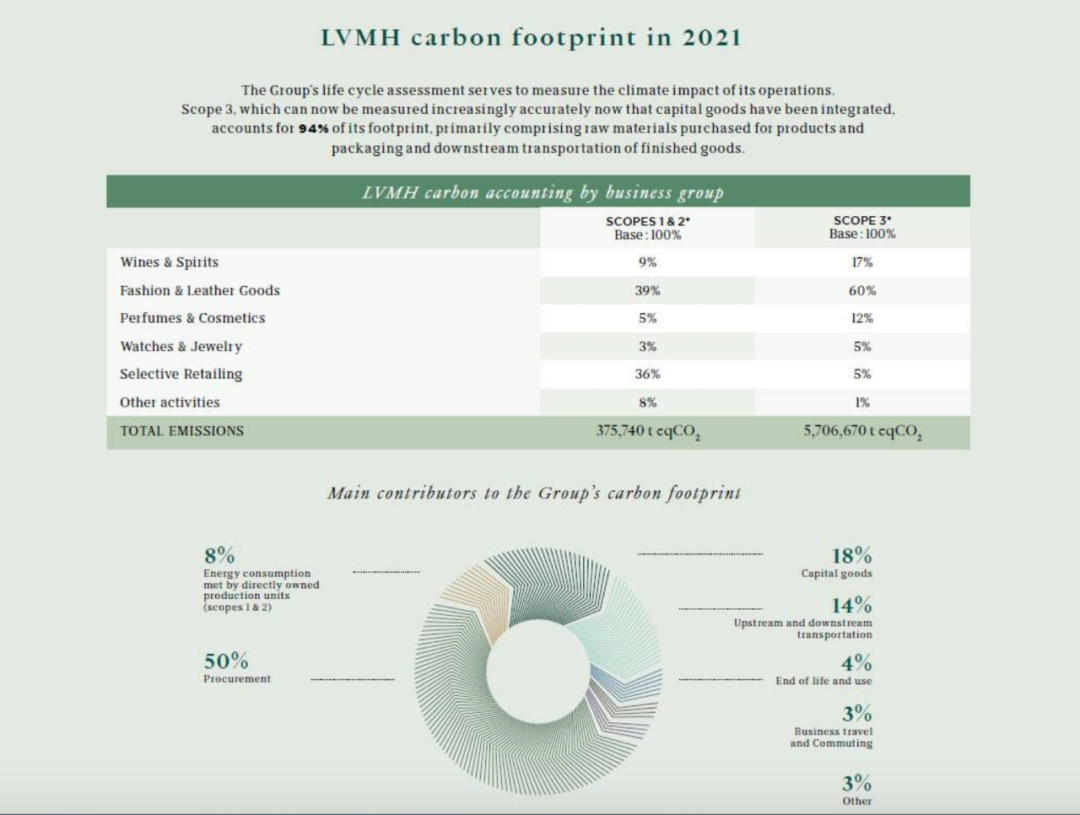
Source: LVMH Official Website
At the same time, the LVMH Group calculated the carbon emissions generated by each business segment within Scope 1 and Scope 2. The LVMH Group's carbon emissions in these scopes exceeded 300,000 tons over the past three years. Among them, fashion and leather goods are the sectors with the highest carbon emissions, reaching 150,000 tons in 2021. Notably, indirect emissions from Scope 2 account for about 80% of total emissions.
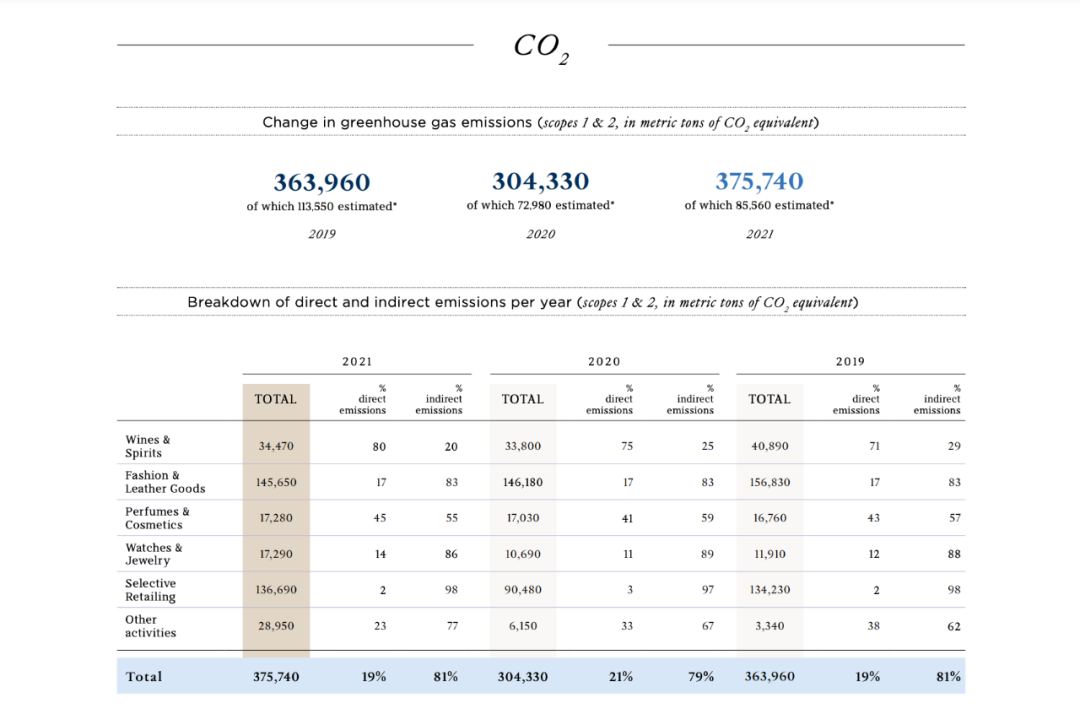
Source: LVMH Official Website
02 Reducing(减碳)
"After setting carbon neutrality goals and calculating carbon emission data, the first thing a company should think about is to identify 'hotspots' of carbon emissions and reduce them as much as possible."
To achieve the reduction targets for Scope 1 and Scope 2, the main measures taken by LVMH include:
1. Renewable Energy Reduction
By 2026, all regions and stores of LVMH will use renewable or low-carbon energy comprehensively, implement an eco-friendly e-commerce plan, and collaborate with the livestock sector to develop methane with high heating potential.
Starting from 2023, LVMH Group will cooperate with SAVE Energies, the second-largest biogas procurer in France, for a three-year partnership to replace fossil fuels consumed by the LVMH Group in France with biogas. In addition, some brands under the LVMH Group, such as Hennessy and Guerlain, have already started using biogas.
2. Store Energy Efficiency
80% of LVMH's greenhouse gas emissions come directly from the energy consumption of its 4,700 stores, which cover nearly 1.5 million square meters—equivalent to 200 football fields. Therefore, store emission reduction is crucial to LVMH's emission reduction targets.
Thus, LVMH requires all production, management sites, and stores to improve their environmental performance indicators (including water usage, energy consumption, waste emissions, etc.) by at least 10%. Additionally, the Group formulated the "LVMH Lighting Program" in 2013, aiming to help brands obtain sufficient lighting while reducing energy consumption through the full utilization of new LED solutions.
For Scope 3 emission reductions, LVMH focuses mainly on supply chains, product transportation, and waste disposal.
1. Highest Standard Procurement Chain
More closely monitor the traceability and compliance of raw materials and ingredients used in the production of products that highlight the Group's excellence while protecting natural resources. By 2020, 70% of the procurement chain adopted the highest standards, and by 2025, 100% of the procurement chain will adopt the highest standards. LVMH and its 75 brands support the development of alternative circular economy solutions, including smart design and game-changing innovations, such as using agricultural residues, recycled textiles, and microbial cellulose to manufacture paper, packaging, and textiles.
Additionally, LVMH collaborates with the non-profit environmental organization Canopy to promote eco-friendly packaging and protect forest resources. LVMH's commitments include: ensuring that by the end of 2022, the paper, paper packaging, and textile supply chains no longer use raw materials from ancient and endangered forests, protecting the remaining forests and habitats of endangered species in the world.
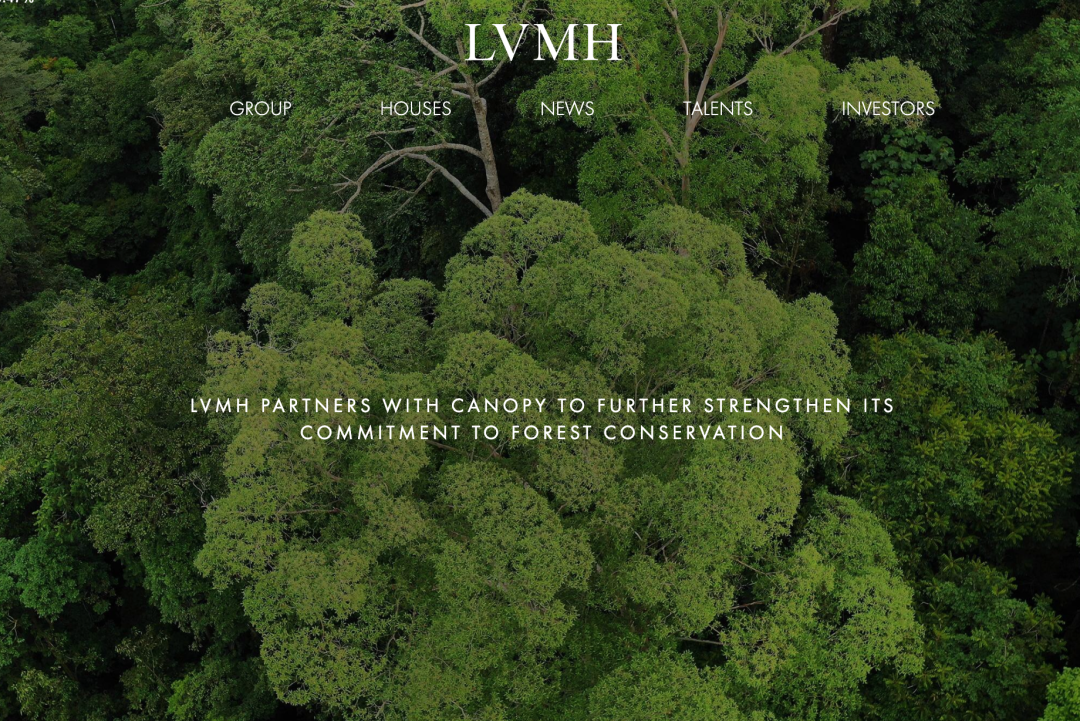
Image Source: LVMH Official Website
2. Product Transportation
Most of LVMH's perfumes and cosmetics were transported by air last year, leaving significant room for improvement. The greenhouse gas emissions from the transportation of materials and finished products by the Fashion and Leather Goods department via air freight are also substantial, offering considerable potential for improvement. In terms of product transportation, LVMH plans to increase the use of sea freight, significantly reducing carbon emissions in this area.According to calculations by Carbonstop, the reduction ratio of carbon emissions from sea freight compared to air freight is approximately 99%.
3. Creative Circularity
LVMH is enthusiastic about adopting a new "creative circularity" approach in all its activities and has set corresponding targets:
Firstly, by 2030, 25% of LVMH's profits will come from circular services rather than new products, such as initiatives to recycle unsold items, repair services to make luxury goods more durable, upcycling, utilizing existing inventory to manufacture clothing, and exploring alternative materials.
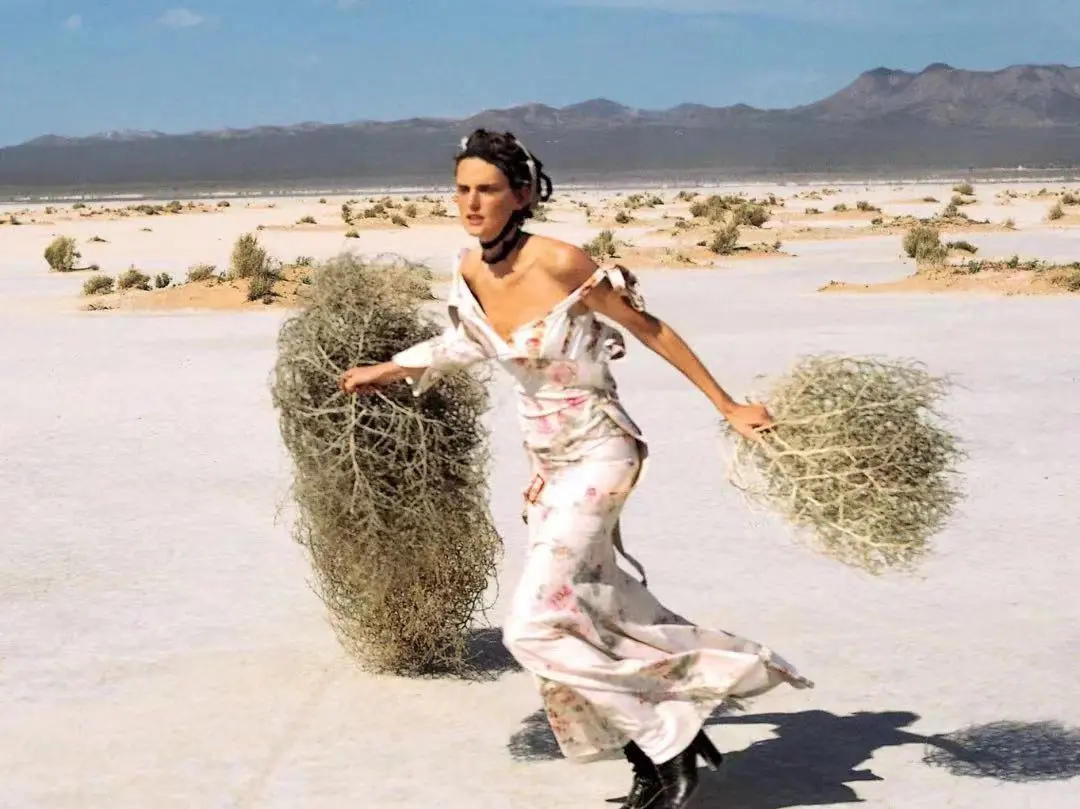
Image Source: Vogue
Moreover, LVMH requires that 100% of its products adopt an eco-design approach and develop new circular services.The Group aims to ensure that all new products comply with eco-design principles by 2030, minimizing environmental impacts from raw material extraction to transformation.This means that all businesses under the Group, from fashion and leather goods to wine and selective retail, will participate in upgrades. For example, in raw material selection, although fur is not eliminated, there is a shift from traditional leather to natural materials sourced from regenerative farms.
03 Engaging(带动)
"For most companies, besides reducing their own emissions, how to mobilize internal members and ecological partners to reduce emissions together is where the real value lies."
1. LVMH Environmental Academy Engages Employees
Since 2016, the Group has continuously improved employees' environmental awareness through the Environmental Academy and provided guidance and training in protecting natural resources. The Environmental Academy uses a variety of teaching resources, including face-to-face courses, online learning, and virtual classrooms, to create courses.
The Environmental Academy also offers a core training course on basic knowledge. This course primarily covers important environmental challenges, the operation of environmental management systems, and environmental law. Additionally, the Academy hosts discussion meetings organized by researchers, professors, philosophers, or institutional presidents, known as LIFEvent meetings. These meetings are mainly aimed at the Group's environmental directors and managers to enhance their understanding of environmental issues and provide them with an overview of current hot topics.
2. Blockchain Traceability Engages Consumers
LVMH commits to using blockchain traceability for every major material by 2030. As consumer expectations for transparency continue to rise, LVMH is testing the use of QR codes to introduce the components of each garment and ensure the origin of materials used throughout the value chain with its French classic designer brand Patou.
3. Online Resale Platform Engages the Ecosystem
LVMH Group launched Nona Source in 2021, an online resale platform dedicated to the "re-procurement of premium materials." It aims to resell high-quality inventory materials from fashion and leather goods brands under the Group through online channels. This platform sells different materials, weights, colors, and patterns stored in the warehouses of LVMH's fashion and leather houses to emerging designers and brands in Europe at competitive prices, encouraging creative reuse of materials and bringing a true revolution to the procurement field.
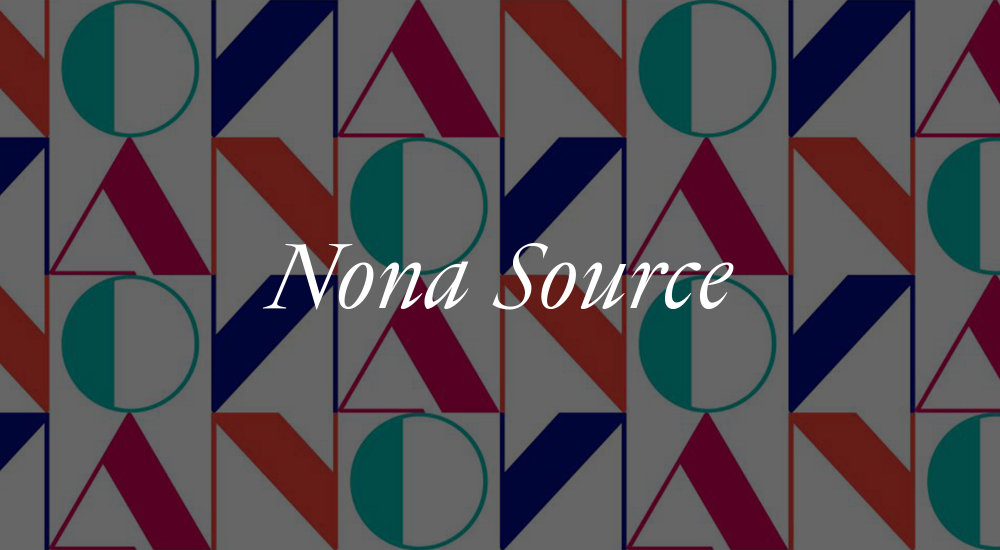
Image Source: LVMH Official Website
04 Offsetting(抵消)
"Unavoidable carbon emissions can be offset by planting trees or purchasing carbon credits to achieve 'zero emissions'"
LVMH established an internal carbon fund to raise 5 million euros for renewable energy production. In 2015, LVMH Group established an internal carbon fund, managed by the Group's environmental department and expert teams, which began receiving contributions from LVMH subsidiaries in 2016.
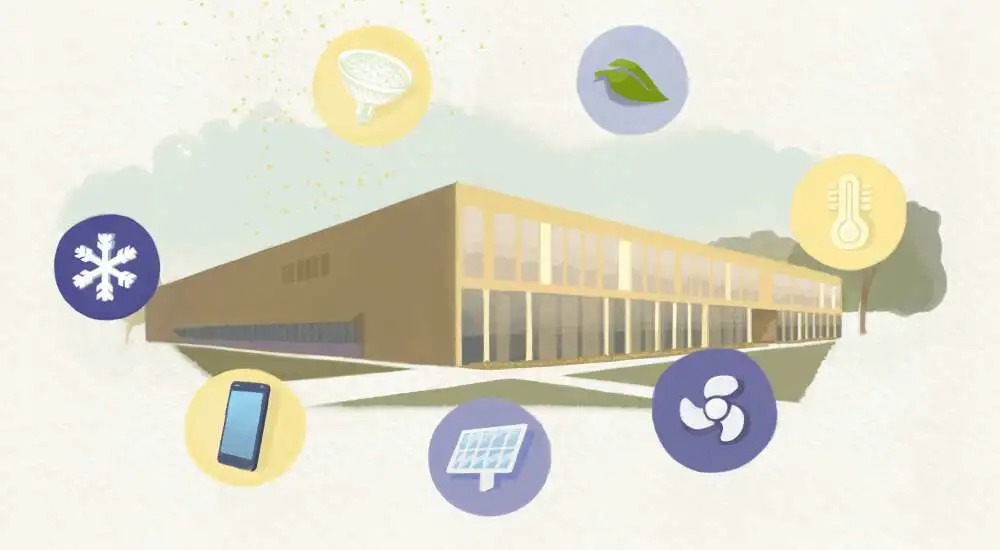
Image Source: LVMH Official Website
The donation amount is based on the greenhouse gas emissions generated by their respective activities. It is used to fund investments aimed at reducing greenhouse gas emissions from LVMH's various brands, creating a virtuous cycle. The three major projects eligible for funding are: investment in energy efficiency equipment; investments in sustainable energy production on an international scale; and training and development for suppliers.
05 Spreading(传播)
"After proposing carbon neutrality goals and paths, companies should disseminate them as soon as possible to have a greater impact on the industry."
1. LVMH Climate Week
In 2020, five years after the signing of the Paris Agreement, the Group held the "LVMH Climate Week" event. Through "LVMH Climate Week," LVMH showcased 49 solutions to address climate change to its partners.
Among them, Desserto, a startup that made it to the finals of the "2020 LVMH Innovation Award," introduced a plant-based material made from cactus grown in Mexico. This material can be used to make leather goods or product packaging. Secante developed custom LED solutions, while Celsius offered geothermal solutions for heating and cooling buildings to maintain comfortable temperatures with low carbon emissions.

Source: LVMH Official Website
2. Embedding Environmental Concepts in Fashion Shows
LVMH's designers have a strong interest in discussing sustainability in production and design. Maria Grazia Chiuri clearly conveyed this message at the Dior Spring/Summer 2020 show in September, displaying 164 trees of different European species on the runway. After the show, these trees were replanted elsewhere to demonstrate the importance of biodiversity. The outfits featured extensive use of raffia as direct fabric material, along with botanical specimens and fresh grass prints, guiding the public to reflect inwardly: Can we rebuild our relationship with nature?
3. Participating in the China International Import Expo
LVMH Group participated in the China International Import Expo, where the fourth edition was themed "Nature and Creativity," establishing a new alliance for sustainable development. Adhering to the principles of the LIFE 360 environmental initiative, the Group's various brands exhibited highlights of their efforts in sustainable development at the expo pavilion, such as Louis Vuitton's Felt Line series made from eco-materials and sneakers composed of over 90% recycled and bio-based materials.
Conclusion
As the world's largest luxury empire, LVMH's sustainable development plan is gradually maturing. It is reported that the Group reduced greenhouse gas emissions by nearly 2,500 tons in 2021, but its continued use of exotic animal skins and fur has been criticized. The road to environmental protection in the fashion industry will inevitably involve a struggle against consumerism, with the biggest problem being production excess driven by the promotion of consumption. If this model is not fundamentally changed, even the most sustainable strategies will be like a drop in the bucket.
